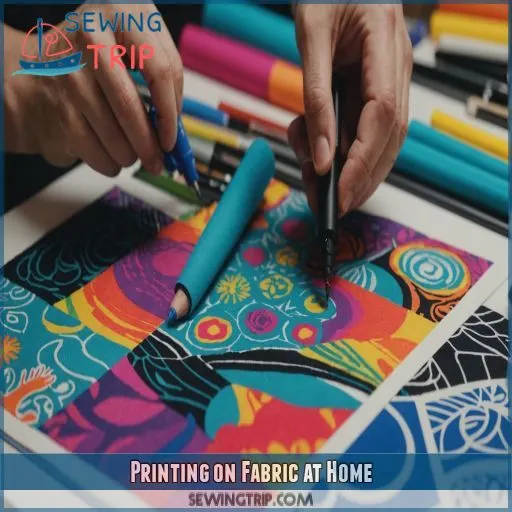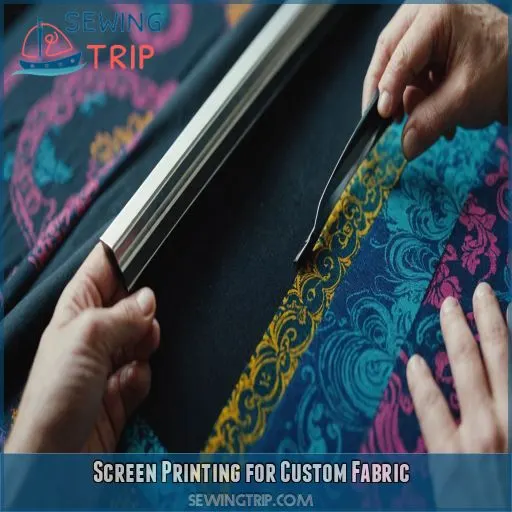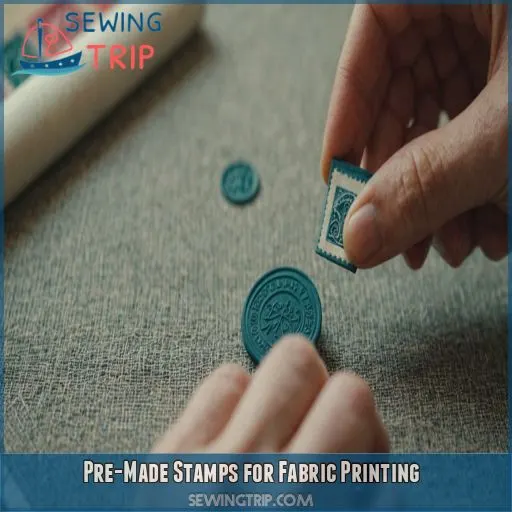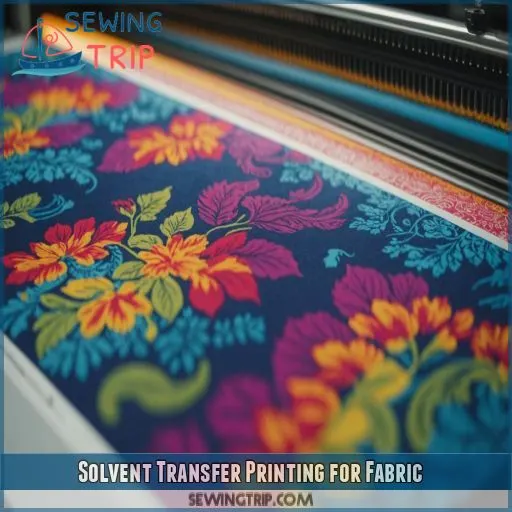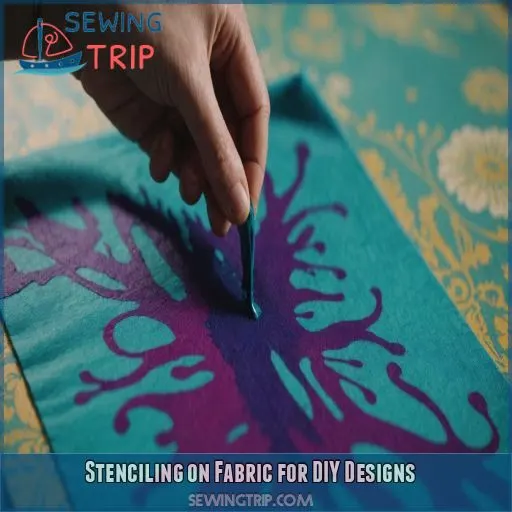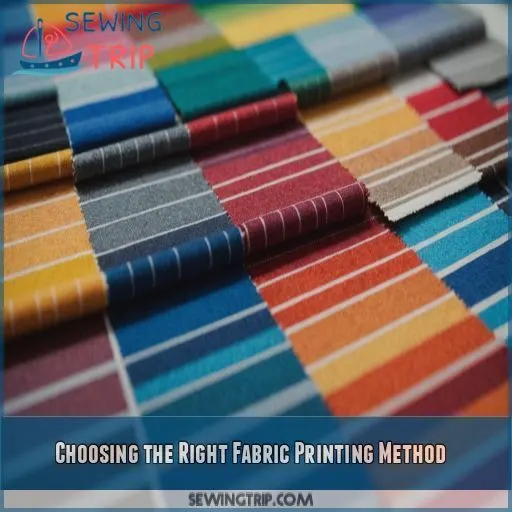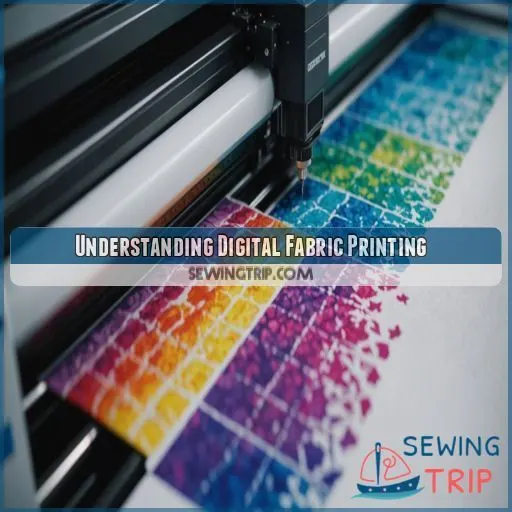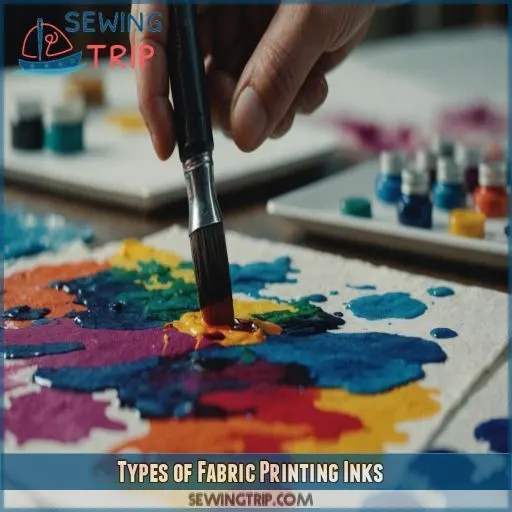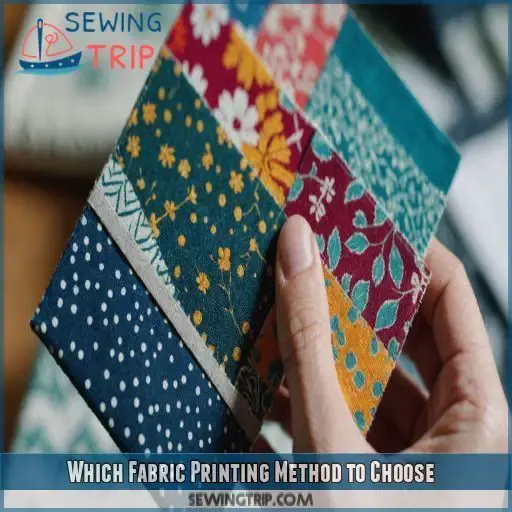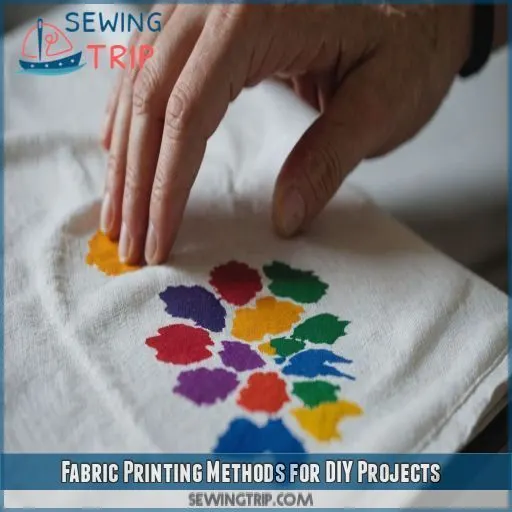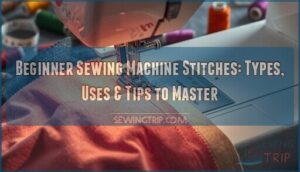This site is supported by our readers. We may earn a commission, at no cost to you, if you purchase through links.
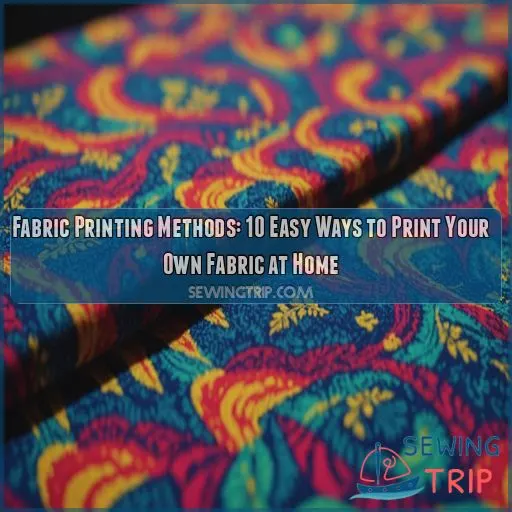
For instance, you can use your inkjet printer, fabric transfer paper, or even make your own stencils with freezer paper.
If you’re feeling extra crafty, you can try screen printing, stamp printing, or solvent transfer printing.
Each method has its pros and cons, so it’s worth checking out a few options before you jump in.
For example, laser printers work better for solvent transfers, and silk screens are cost-effective for bulk printing.
Read on to discover more about these methods and find the best fit for your DIY project.
Table Of Contents
- Key Takeaways
- Printing on Fabric at Home
- Screen Printing for Custom Fabric
- Pre-Made Stamps for Fabric Printing
- Solvent Transfer Printing for Fabric
- Stenciling on Fabric for DIY Designs
- Choosing the Right Fabric Printing Method
- Understanding Digital Fabric Printing
- Types of Fabric Printing Inks
- Which Fabric Printing Method to Choose
- Fabric Printing Methods for DIY Projects
- Frequently Asked Questions (FAQs)
- Conclusion
Key Takeaways
- There are tons of ways to print your own fabric at home, from using your trusty inkjet printer to screen printing and even stamping.
- Fabric transfer paper and freezer paper both have their pros for printing. Transfer paper lets you do full-color transfers, while freezer paper is great for making custom stencils.
- Solvent transfer printing uses Citrasolv to move ink from paper to fabric. It’s eco-friendly but might not be as vibrant or long-lasting as other methods, so you can paint over it for extra pop and protection.
- Digital pigment printing is the future of fabric printing. It’s sustainable, efficient, and flexible, offering high-quality, consistent results on various fabrics.
Printing on Fabric at Home
Are you itching to get crafty and add some personality to your fabrics? You’re in luck! We’ll show you how to print your own fabric at home with five simple methods that will have you creating custom designs in no time.
5 Easy Methods for DIY Printing
- Printing with Your Home Printer
- Screen Printing with a Cricut
- Using Pre-Made Stamps
- Solvent Transfer Printing
- Stenciling on Fabric
Using Your Home Inkjet Printer
Printing on fabric at home is a fun and creative way to personalize your projects. You can use your trusty inkjet printer to achieve this, and here’s a quick guide to get you started.
| Inkjet Printer Types | Fabric Types |
|---|---|
| Inkjet printers with pigment inks | Cotton, polyester, blends |
Remember to always check the manufacturer’s instructions for your specific printer model and pick the right fabric type to get the best results. Happy printing!
Fabric Transfer Paper Vs Freezer Paper
Printing on fabric at home? You’ve probably heard of fabric transfer paper and freezer paper. But which one’s better for your project?
Fabric Transfer Paper Pros:
- Full-color transfers.
Freezer Paper Pros:
- Can be used to create custom stencils for stencil printing.
Printable Fabric Sheets and Tutorials
Printable fabric sheets are a great option for printing on fabric at home. You can find these sheets at craft stores or online, and they’re designed to work with your home inkjet printer.
If you’re looking for a step-by-step guide, The Graphics Fairy provides a helpful tutorial on printing on fabric sheets.
Inkjet Vs Laser Printers for Fabric Printing
Printing on fabric at home? You’ve probably wondered about inkjet vs. laser printers. Inkjet printers are the clear winner for direct fabric printing. Laser printers, unfortunately, aren’t built for that kind of party.
Screen Printing for Custom Fabric
So, you want to try your hand at screen printing for custom fabric? It’s a fun and creative way to personalize your fabrics and make something truly unique. Whether you’re crafting custom labels, tea towels, or something else, screen printing offers a versatile and accessible method for bringing your designs to life.
Creating Custom Silk Screens With a Cricut
Want to try your hand at screen printing?
Creating custom silk screens using a Cricut or similar cutting machine is a great way to get started.
This method is perfect for those who want to try their hand at screen printing.
With a Cricut, you can design and cut your own silk screen stencils, opening up a world of creative possibilities for custom fabric printing.
Whether you’re a beginner or a pro, this technique offers a fun and unique way to personalize your fabrics.
Reusable Silk Screens for Multiple Designs
Reusable silk screens are a fantastic option if you plan on printing multiple designs. With proper care, these screens can be used again and again, making them a cost-effective choice for your custom fabric projects. Imagine creating a range of unique designs and bringing them to life with this versatile method. The possibilities are endless!
Fabric Paint and Screen Printing Ink
Now, let’s talk about the fun part: fabric paint and screen printing ink. These are the lifeblood of your custom fabric creations. With the right ink or paint, you can transform plain fabric into a vibrant masterpiece. But, it’s not just about looks; you need to think about how it works, too.
When choosing your ink or paint, go for options specifically designed for fabric. These are formulated to adhere to the unique characteristics of fabric, ensuring your design lasts through washes and everyday wear and tear.
Online Instructions for Silk Screen Stencils
You’ve got your fabric paint and screen printing ink, now what? Well, you’re in luck because there are online instructions for creating silk screen stencils.
Here are some tips to get you started:
- Design Ideas: Think about the image or pattern you want to create. Simple designs with bold lines work best for stencils.
- DIY Tools: You can make your own stencils using materials like freezer paper, cutting machines, or a craft knife.
- Printing Techniques: Practice on scrap fabric to get a feel for the amount of pressure and speed needed for a clean print.
- Stenciling on Different Fabrics: Experiment with different fabrics like cotton, polyester, or blends to see how the ink behaves and adjust your technique accordingly.
Pre-Made Stamps for Fabric Printing
Ready to kick things up a notch with your fabric printing game? Pre-made stamps offer a treasure trove of designs and styles to elevate your creations. From combining stamps for unique looks to DIY hot glue stamps for wood grain patterns, the possibilities are endless.
Variety of Designs and Styles
Pre-made stamps offer a quick and easy way to get started with fabric printing with a variety of designs and styles at your fingertips. From intricate patterns to simple shapes, you can find pre-made stamps in many craft stores or online.
| Type of Stamp | Design Ideas | Fabric Options |
|---|---|---|
| Pre-made Stamps | Intricate patterns, simple shapes | Muslin fabric ribbon |
| DIY Hot Glue Stamps | Wood grain patterns | |
| Sponge Stamps | Tote bags |
Combining Stamps for Unique Designs
Combining pre-made stamps is a fun way to create unique designs for fabric printing. Here are three tips to help you master this technique:
- Layered Patterns: Experiment with layering different stamps to create intricate patterns and textures.
- Mixed Textures: Play with different stamp textures to achieve a variety of imprint styles.
- Color Blending: Try blending colors by using multiple ink shades.
DIY Hot Glue Stamps for Wood Grain Patterns
If you’re feeling crafty, try making your own hot glue stamps to create wood grain patterns on fabric. It’s a fun DIY project that lets you customize your own unique stamps. Here are some tips to get you started:
| Tip | Description |
|---|---|
| Design | Plan your wood grain pattern. Simple designs work best for hot glue stamps. |
| Hot Glue Gun | Use a low-temperature glue gun to avoid burning yourself. |
| Stamp Material | Create your stamp on a sturdy surface like cardboard or wood. |
| Stamp Creation | Carefully draw your design with hot glue. Layer the glue to create a 3D effect. |
| Stamp Testing | Test your stamp on paper first to make sure the design transfers well. |
With these tips, you can create beautiful wood grain patterns on fabric using your own DIY hot glue stamps.
Muslin Fabric Ribbon and Sponge Stamps
Muslin fabric ribbon is perfect for hand-printing with pre-made stamps.
You can use sponge stamps to create unique designs on tote bags or other fabric items.
This method offers an easy way to personalize your fabric with custom images and patterns, making it ideal for small businesses or consumers seeking one-of-a-kind creations.
With these simple techniques, you can elevate your DIY stamp projects and fabric art to the next level.
Solvent Transfer Printing for Fabric
Solvent transfer printing is a unique method that uses a product called Citrisolv to transfer ink from printer paper onto fabric. While it may not produce the most durable or colorfast results, you can enhance the design by painting over it with fabric paint or ink.
Using Citrisolv for Solvent Transfer
Citrisolv is a product used for solvent transfer printing. It’s an eco-friendly, DIY-friendly method for printing on fabric at home. Here are some key things to know:
- Citrisolv safety: Always follow safety precautions when using Citrisolv. It’s important to work in a well-ventilated area and wear protective gear, such as gloves and a mask.
- Transfer paper types: While Citrisolv can be used with both inkjet and laser printers, laser printers tend to provide better results for solvent transfer printing.
- Colorfastness tips: Solvent transfer printing may not yield as vibrant or long-lasting results as other methods. Consider using fabric paint or ink to enhance the color and durability of your design.
- Print quality: Solvent transfer printing offers a unique, handmade look. The print quality may vary, and it’s important to manage your expectations, especially if you’re new to this method.
Laser Printers for Solvent Transfer
Laser printers are the preferred choice for solvent transfer printing. While inkjet printers can be used, laser printers offer better results and are more commonly recommended for this technique.
Now, let’s get into the specifics of laser printer types and how they impact the solvent transfer printing process.
Printer Paper for Transferring Ink
For solvent transfer printing, you’ll need to grab some regular printer paper to transfer ink onto your fabric. It’s a simple and affordable option, but keep in mind that the ink won’t be as durable or colourfast as other methods.
Colorfastness and Durability of Solvent Transfers
Solvent transfer printing is a versatile method for printing on fabric, but it has some limitations in terms of colorfastness and durability.
While it’s a handy technique for DIY projects, the colors may not stand the test of time and multiple washes.
So, if you’re aiming for long-lasting prints that won’t fade, this method might not be your first pick.
But, if you’re feeling creative, you can extend the lifespan of your designs by painting over solvent transfers with fabric paint or ink.
This adds a protective layer, ensuring your creations stay vibrant for longer.
Stenciling on Fabric for DIY Designs
Stenciling on fabric is a fun, DIY way to create unique designs on t-shirts, towels, and more. You can make your own stencils with freezer paper and a Cricut cutting machine, or even hand-cut them with a craft knife.
Layered and Reusable Stencils
Layered and reusable stencils are a versatile way to create custom designs on fabric. With stenciling, you can layer different stencil designs to achieve intricate patterns and reuse them for multiple projects, making it an efficient and cost-effective method for DIY enthusiasts.
Imagine the possibilities of layering stencils to create unique, one-of-a-kind designs that reflect your personal style. Whether you’re crafting a trendy t-shirt or adding a touch of flair to a throw pillow, layered and reusable stencils offer endless customization.
Freezer Paper Stencils and Cutting Machines
Stenciling on fabric opens up a world of DIY design possibilities.
You can create custom patterns and designs using freezer paper stencils and a cutting machine, like a Cricut.
This method offers the freedom to experiment with different ideas and bring your unique vision to life.
Whether you’re crafting a one-of-a-kind shirt or embellishing home decor, freezer paper stencils provide a versatile and cost-effective option for your creative endeavors.
Hand-Cut Stencils and Fabric Items
Hand-cut stencils are a fun, creative way to design fabric items. With a craft knife, you can draw and cut your own unique stencils. Here are some ideas to get you started:
- T-shirts
- Towels
- Pillows
Choosing the Right Fabric Printing Method
So, you’ve explored a bunch of fabric printing methods and now you’re wondering which one’s the right fit for your project. Well, grab a cuppa and let’s take a closer look at the pros and cons of each method to help you pick the perfect one.
Screen Printing for Bulk Orders
If you’re thinking big, screen printing is the way to go for bulk orders. It’s a traditional method using mesh screens and stencils to transfer ink onto fabric. While it’s not suitable for small runs due to setup costs, it’s perfect for mass production.
Here’s a table comparing screen printing with other methods:
| Method | Setup Costs | Bulk Order Pricing |
|---|---|---|
| Screen Printing | High | Low |
| Digital Printing | Low | High |
| Roll-to-Roll Printing | Medium | Low |
Digital Printing for Small Runs and Samples
Digital printing is your best bet for small runs and samples.
Why? It’s super versatile. You can print individual pieces or short runs without breaking the bank.
Plus, you’re not limited by color – digital printing lets you go wild without affecting the cost.
Need something quick? Digital printing’s got your back with lightning-fast turnaround times.
And it’s not picky about fabric either. Cotton, polyester, blends – it works with them all.
Roll-to-Roll Printing for Large-Scale Production
Roll-to-roll printing is a high-speed method ideal for large-scale production.
It prints directly onto fabric rolls, making it a perfect choice for printing various designs on apparel, home furnishings, and industrial textiles.
With its ability to handle large volumes, roll-to-roll printing is a cost-effective solution for businesses needing bulk orders.
Pigment Inks, Dye-Sublimation, and Reactive Dyes
Pigment inks, dye-sublimation, and reactive dyes—oh my! With so many fabric printing methods, how do you pick the right one? Well, it depends on what you’re printing and your must-haves.
Pigment inks are like the versatile, low-maintenance friend who gets along with everyone. They’re water-based and can be used on a bunch of fabrics, like cotton, polyester, and blends.
Dye-sublimation inks, on the other hand, are the life of the party. They create vibrant, long-lasting prints, especially on synthetic fabrics like polyester.
Reactive dyes are the sensitive type. They bond with certain fabrics, like cotton and linen, creating a lasting relationship.
Understanding Digital Fabric Printing
Whether you’re a DIY enthusiast or a small business owner, understanding digital fabric printing is key to creating unique, custom fabrics. This method offers versatility, letting you print individual pieces or small batches with any number of colors, making it ideal for samples and various fabric types.
Digital Pigment Fabric Printing for Sustainability
Digital pigment fabric printing is an emerging method that offers sustainability benefits and high print quality. Here’s why it’s a game-changer:
- It’s eco-friendly: Digital pigment printing reduces your carbon footprint by minimizing waste and using cleaner processes. No more water or pre-treatment, which is a win for the environment and your wallet.
- It’s versatile: This method works on a range of fabrics, from natural fibers to synthetic blends, giving you the freedom to experiment with different materials.
- It’s consistent: The Kornit method guarantees precise and repeatable results, so you can trust that your designs will turn out perfectly every time.
Kornit’s Patented System for Organic Inks
Kornit’s patented system is a game-changer for eco-friendly printing.
It uses organic inks and eliminates the need for water and pre-treatment, making it a top choice for fabric printing manufacturers, suppliers, and retailers.
With Kornit ink, you can achieve consistent, high-quality results on natural fibers, synthetic fabrics, and blends, all while reducing your environmental impact.
This innovative method is leading the way toward a greener future in the textile industry.
Reducing Carbon Footprint With Digital Printing
Digital printing is a game-changer, offering a more sustainable approach to fabric printing. Here’s how it reduces the carbon footprint in the textile industry:
- Eco-Friendly Printing: Less water, less waste.
- Organic Inks: Kornit’s system uses organic inks and binders, skipping pre-treatment.
- Textile Sustainability: No separate screens for colors = simpler, less waste.
- Flexibility: Perfect for small runs and quick turnarounds.
Revolutionizing the Textile Industry With Digital Printing
Digital printing is revolutionizing the textile industry, offering efficiency and sustainability. It’s versatile, letting you print individual pieces or small batches with any number of colors. It’s also quick, making it ideal for samples. This method works with various fabrics like cotton, polyester, and blends. With its flexibility and affordability, digital printing is becoming more and more popular.
Types of Fabric Printing Inks
So you’ve picked your printing method, but now what? It’s time to talk ink. The type of ink you choose is just as important as the printing method itself, impacting the durability, colour, and fabric compatibility of your design.
Let’s explore the different types of fabric printing inks and how they can affect your DIY fabric printing projects.
Pigment Inks for Durability and Versatility
For fabric printing inks, pigment inks really stand out because they last a long time and can be used in so many ways. These water-based inks are suspended in a binder, which makes them work on lots of different fabrics, from cotton to polyester blends.
Since they’re durable and don’t fade easily, pigment inks are perfect for fabric printing projects you want to last. They’re a popular choice for digital printing and roll-to-roll printing methods, and they’re only going to get more popular because they’re so adaptable and reliable.
Dye-Sublimation Inks for Vibrant Colors
Dye-sublimation inks are a popular choice for achieving vibrant, long-lasting prints on fabric. This heat transfer process is ideal for synthetic fabrics, especially polyester. Here are three key points about dye-sublimation inks:
- They produce vivid colors that really pop, making them perfect for sportswear, banners, and flags.
- These inks are designed specifically for use with sublimation printers and polyester fabrics.
- The heat transfer process makes sure that the dye bonds permanently to the fabric, resulting in colorfastness and durability.
Reactive Dyes for Cellulose Fibers
Reactive dyes are perfect for printing on cellulose fibers like cotton, linen, rayon, hemp, and bamboo. They create a chemical bond with the fabric, resulting in vibrant and long-lasting colors.
| Fiber Type | Examples | Reactive Dye Compatibility |
|---|---|---|
| Cellulose Fibers | Cotton, Linen | ✅ Yes |
| Rayon, Hemp, Bamboo | ✅ Yes | |
| Protein Fibers | Silk, Wool | ❌ No |
Acid Dyes for Protein Fibers
Now, let’s talk about acid dyes, which are like the yin to the yang of reactive dyes. If you’re looking to dye protein fibers like silk, wool, or nylon, acid dyes are your go-to. These dyes are picky and only work with protein fibers.
When it comes to acid dye colorfastness, getting the dye bath temperature right is really important. Too hot, and the dye will be unevenly absorbed. Too cold, and it won’t take at all. Follow the instructions for your specific dye to get it just right.
Which Fabric Printing Method to Choose
So many methods, so little time! Choosing the right fabric printing method depends on your project’s scope, design complexity, and fabric type. Let’s take a closer look at the pros and cons of each technique to help you pick the perfect one for your DIY adventures.
Analogue Printing With Screen Printing
Screen printing is a traditional analogue method that uses a mesh screen and stencil to transfer ink onto fabric. Here’s what you need to know:
- Screen Printing Tools: You’ll need a mesh screen, stencil, squeegee, and ink. Screens and stencils can be custom-made or bought pre-made.
- Fabric Types: Screen printing works on a variety of fabrics, but it’s important to choose the right ink for the fabric type.
- Ink Choices: There are a variety of inks to choose from, including fabric paint and screen printing ink.
Colour Reproduction in Textile Printing
So, you wanna nail that color accuracy and get your prints poppin’ in all the right ways? Let’s talk about color reproduction in textile printing and how to choose the right method for your fabric fun.
First off, there’s the analogue route with screen printing. This old-school method’s got its perks, but for color, it’s a bit like herding cats. Each color needs its own screen, so it can get fussy and pricey real quick. But hey, if you’re after that vintage vibe, screen printing might still be your jam.
Now, let’s swing over to the digital side. With digital printing, you’re free to play with colors like a kid in a candy store. No limits, no separate screens, just endless possibilities for your designs. It’s a breeze for small runs and samples, too, so you can test things out without breaking the bank.
Fabric Printing Methods for DIY Projects
So, you’re keen to try your hand at fabric printing but aren’t sure where to start? Well, get ready to roll up your sleeves and jump into the world of DIY fabric printing! From printing with your home printer to screen printing and even creating your own stamps, there’s a method for every creative itch. Let’s get crafting!
Infographic for Fabric Printing Methods
! [Fabric Printing Methods Infographic](Insert infographic here)
Does Printing Method Matter for Fabric Quality?
Yes, it matters a lot. The printing method affects colorfastness, durability, and fabric type. For instance, solvent transfer printing isn’t as colorfast or durable as other methods. Dye-sublimation printing only works with synthetic fabrics. So, pick a method that suits your fabric and desired print quality.
Future of Fabric Printing With Digital Pigment Printing
The future of fabric printing is digital pigment printing, and it’s easy to see why. Here are three reasons why this method is set to dominate:
- Sustainability:
- Efficiency:
- Flexibility:
Frequently Asked Questions (FAQs)
How can I print on fabric at home?
You’re raring to go, champ, but first, choose your weapon: iron-on transfer paper, freezer paper, fabric sheets, or inkjet/bubble jet printers. There’s no one-size-fits-all, so pick your poison and get printing.
What is the newest method of fabric printing?
Sublimation printing is one of the newest fabric printing methods. It uses heat to transfer dye onto fabric, resulting in a durable and fade-resistant print.
What are the four techniques used in fabric printing?
Traditional textile printing techniques are broadly categorised into four styles: direct printing, mordant printing, resist dyeing, and discharge printing.
What is the most durable way to print on fabric?
If you’re after a design that’s going to last, digital printing with reactive dyes is the way to go. The dye is absorbed by the fabric, so it’s less likely to wash out than pigment ink.
Whats the best way to print photos on fabric?
You can print photos on fabric using dye-sublimation printing, which uses heat and pressure to transfer dye onto the fabric. You can also use an inkjet colour printer with iron-on heat transfer paper, and a hot, dry iron.
Are there any alternatives to silk screening?
What’s your style? If you’re after something fast, fun, and a little fragile, try crayons, oil sticks, or cray pas. For something more heavy-duty, there’s always Tusche and Gum Arabic. Or keep it simple with paper stencils or shelf liner stencils.
Can I use stamps on dark fabric?
Yes, you can use stamps on dark fabric. Use opaque paint, or try stamping with bleach for a faded look. You can also add white to your paint to lighten the shade.
How do I make my fabric prints more durable?
Like a tattoo, fabric prints can fade over time. To keep your prints vibrant: use high-quality settings, good ink, and a hot iron to set the ink. For large amounts of fabric, try digital printing with reactive dyes.
Whats the best method for printing on delicate fabrics?
When printing on delicate fabrics like silk and rayon, use a lower mesh count for your screen. A mesh count of 110-160 is recommended. Pre-treat the fabric with a solution of water and soda ash to help the ink stick well without damaging the fabric.
Conclusion
Ever wondered how to add a personal touch to your fabric projects? With these fabric printing methods for DIY, you can bring your creative vision to life right at home. From inkjet printers to screen printing, and even crafty stamp designs, the options are endless for customizing your fabric. So, which method will you choose to make your mark?

